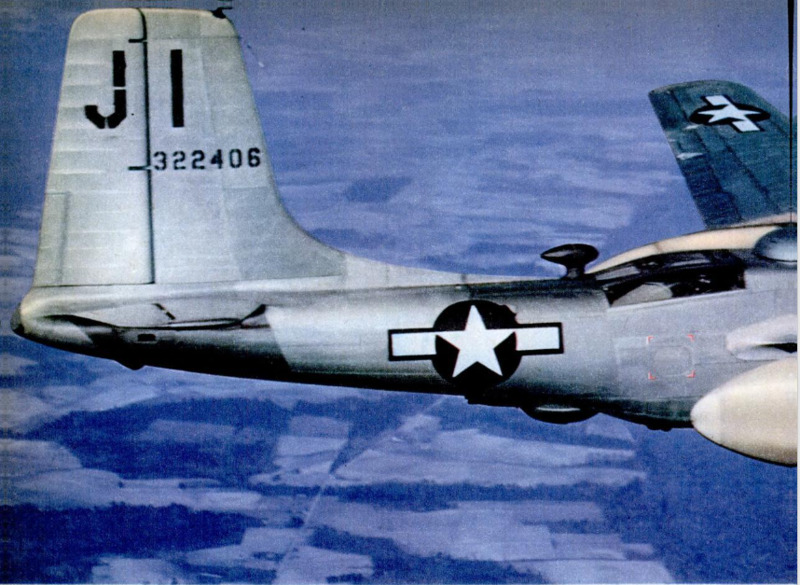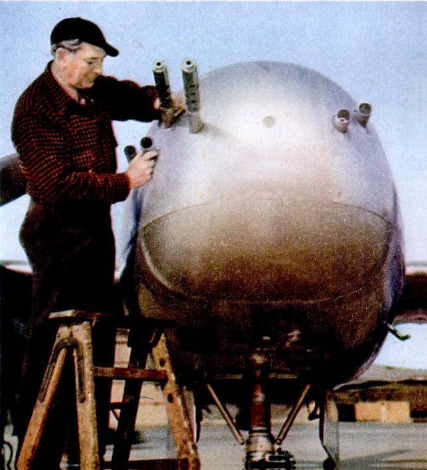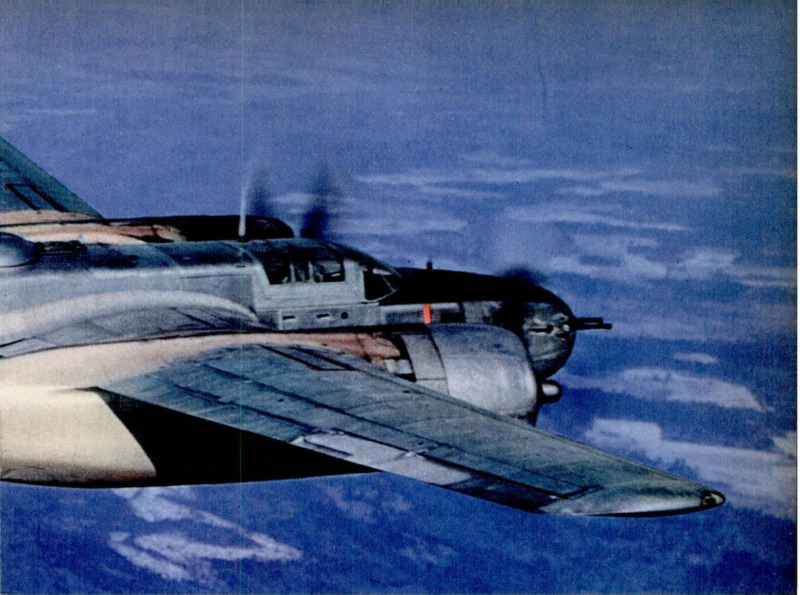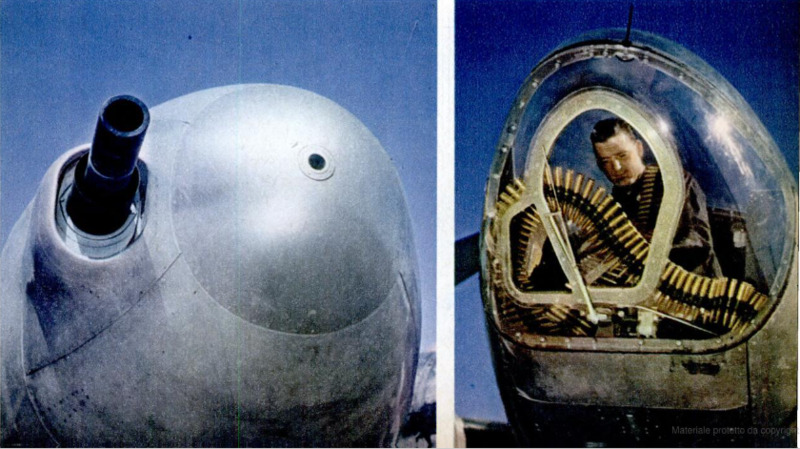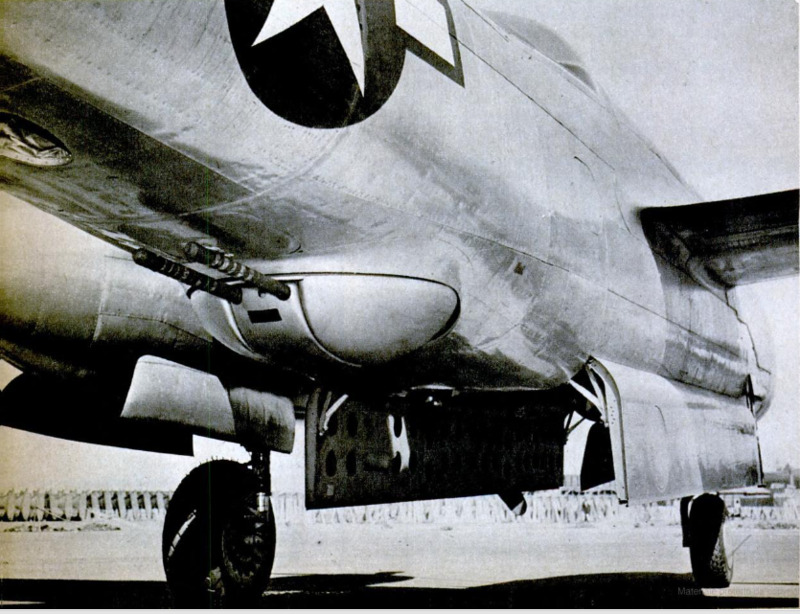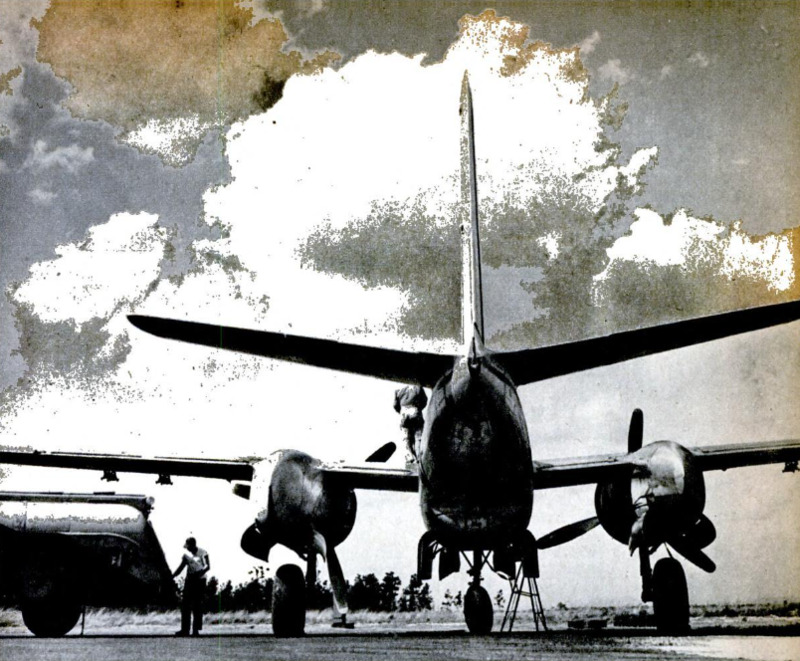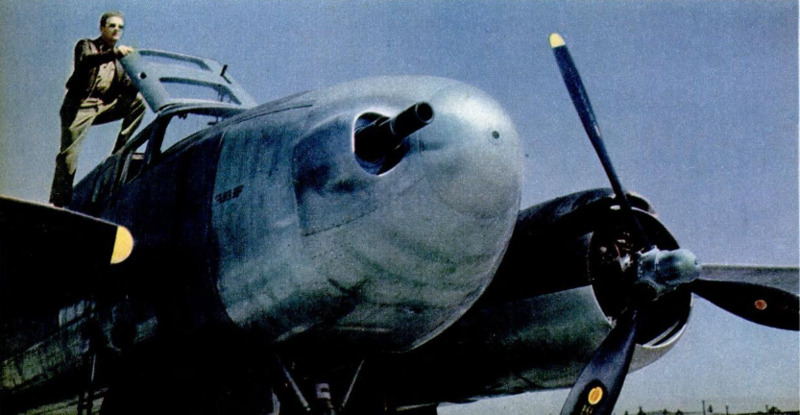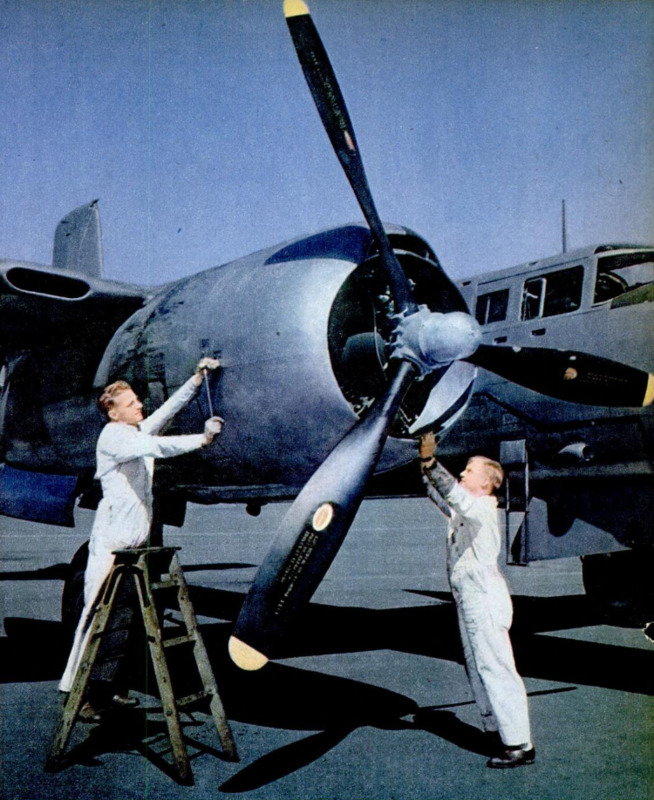-
Title (Dublin Core)
-
Plane of many faces
-
Article Title and/or Image Caption (Dublin Core)
-
Plane of many faces
-
extracted text (Extract Text)
-
You go down the line on an airfield and
you see a group of them with cannon in
their noses, then a group bristling with
machine guns, then a cluster of them with
Plexiglas bombardier greenhouses. You
wonder if you're seeing things, for the
ships all look alike except for the armament
in those long, sleek snouts. You're seeing
things, all right—you're seeing the Douglas
A-26, called the Invader, rigged for just a
few of its various missions. Tactically, the
Invader is just about the most effective
attack bomber in the books.
Watch it take off, as I did recently at the
Air Forces Tactical Center in Florida, and
follow it for a time in the air and you begin
to understand why, new as it is, it is al-
ready making a gaudy reputation for itself
over enemy territory. Officially it's an
attack bomber, but it has more speed than
the A-20 Havoc, which can get right out
and travel. Yet it has more bomb capacity
and a higher ceiling than the B-25 Mitchell,
which is rated at 35,000 pounds loaded
weight and 25,000-foot ceiling.
For a ship of its size—its wing span is
about the same as the B-26 Marauder, but
its fuselage is about the length of the Havoc
—it takes off in a hurry. It climbs unusu-
ally fast, reminding you of a Havoc. Put it
alongside a Havoc, however, and it steadily
pulls away, proving its extra speed. For a
medium bomber, it maneuvers very easily.
This is particularly noticeable when it is in
the air with a Marauder or a Mitchell,
which are not exactly slow in maneuver
themselves.
Name your tactical job and the Invader
can do it — strafing, skip bombing, high-
level bombing, tank busting, pillbox busting,
general attack, reconnaissance, smoke lay-
ing. It can go anywhere in a hurry, take
care of itself in a mix-up with enemy fight-
ers, climb or dive out of trouble, and come
home.
Take the factor of armament and you
begin to sense why the Invader is already
rated the best utility ship in the air. It can
mount anything from a 75-millimeter can-
non to six .50 caliber machine guns in its
nose. It carries additional .50's in upper
and lower turrets. It can carry .50 caliber
package guns under its wings. Just try to
imagine a flight of such ships on a strafing
mission!
Further, it is built to take a variety of
noses on the standard frame—noses de-
signed for anything from straight bombing
to every kind of attack and strafing mission.
In addition to an assortment of guns in the
nose, both the top and belly turrets are
equipped with twin 50's. And there is no
reason why such a ship should not mount
rockets instead of package guns under its
wings.
Yet the Invader can operate with as few
as two men, pilot and gunner. There is
ample room for a third or even a fourth
crewman if needed on a particular mission.
Two things contribute to this ship's ver-
satility and tremendous punch:
First of all, it is fundamentally a fast,
rugged ship of excellent design and flight
characteristics. An all + metal mid - wing
monoplane with single tail and tricycle
landing gear, its twin Pratt & Whitney
double-row engines develop as much power
as the Marauder. Its sleek lines enable it
to make the most of that power. All im-
portant drag elements have been eliminated
or carefully faired in. Pilot's compartment
is of teardrop design. Turrets are of low
silhouette, close-set—so close that you have
to look twice to spot the belly guns.
Second, it can be converted from one job
to another by changing noses. This is made
possible by standardized design and de-
velopment of an assortment of noses.
Quick conversion does not mean changing
the ship's nose in a matter of minutes, but
the change can be made in the field in about
eight hours with no other special equipment
than an improvised crane hoist. Eight
hours is a considerable gain over the time
need 1 to send a ship to a modification
center for conversion.
At present, six different noses are avail-
able for use on the Invader. Some of these
may be further altered or discontinued, as
experience in the fleld dictates. Each has
its special purpose, and none may be con-
sidered a ““standard nose” Noses now
listed, with various combinations of can-
non and .50 caliber guns, are:
1—Plexiglas “greenhouse” for bombing.
2—Metal nose mounting one 75-mm.
cannon,
3—Metal nose with one 75 and two 50's.
4—Metal nose with one 37-mm. cannon
and four .50's.
5—Metal nose with one 20-mm. cannon
and four .50’s.
6—Metal nose with six .50's.
Watch the Invader sweep down across a
field and you can imagine what the Ger-
mans have had to face when this ship was
on a strafing mission, with a flock of those
50's spitting hot steel. Or what it can do
to a tank column or a group of pillboxes,
with that 75 cannon action, supported by all
those 50's. And it comes in on such a
sweep with baffling speed, gets away in a
considerable hurry. If you were trying to
face it down with an’ ack-ack gun you
wouldn't get more than a couple of quick
glimpses of it before it was gone.
It is easy to imagine what this plane can
do on a skip-bombing mission. Its speed
and bomb capacity should make it a highly
respected ship in that category, for it comes
in like the wind, weaves away with excep-
tional dexterity, and is gone.
Take it on as opponent in the air, and you
would have plenty of trouble. Its turrets
are of a type used with remote fire control.
All four of the .50's in those turrets can be
used to ward off attack from the rear or
from either side. From the front, it is sim-
ply devastating. Offhand, it would seem.
that this ship has few, if any, vulnerable
spots. Its guns can pretty well cover all
approaches, and it can throw enough slugs
to break the heart of any armorer loading
its ammunition boxes.
Its field uses depend entirely on situations
as they arise. It was specially designed to
perform any one of a dozen jobs and is not
a composite of other models or an adapta-
tion of earlier designs. It was expected to
make obsolescent three top-ranking planes,
all well known for their powers of devasta-
tion: the A-20 Havoc attack plane, the
B-26 Marauder medium bomber, and the
B-25 Mitchell medium bomber and attack
plane. That's quite an order, but when you
see what it can do you know that these
other doughty ships are going to have to
step right out to hold their prestige. For
here is a ship with more speed, a higher
ceiling, and a greater bomb capacity than
any of those three; in addition it has con-
siderably more firepower, carries close to
a ton of defensive armor, and can cruise at
better than 200 miles an hour on one engine.
Obviously, a ship that can take as well as
give a lot of punishment and still come
home.
But it's that interchangeable nose that
gives the Invader its tremendous tactical
advantage. That's what makes it the
equivalent of six ships in one. To remove
a nose, which is about six feet long, only
six bolts need be removed. When electrical
and gun-control cables have been discon-
nected, the nose can be swung away, a new
nose swung into place, fitted there, and
bolted. It isn’t as simple or as easy as it
sounds, but the job can be done between late
dawn and early dusk—all connections
hooked up, guns loaded, and the ship made
ready for a new kind of mission.
The same kind of job can be done for a
ship with a damaged nose, too—a great ad-
vantage from the repair and maintenance
point of view. Naturally, after a ship has
been in combat and wracked a bit, it isn't
as easy to slip a new nose into place as a
finicky mechanic might wish. But this ship
as a whole gets high praise from the mechs
who work on it.
“For once,” says one mechanic, “they
were thinking about the mech when they
designed her. Why, you can even sit down
in the accessory section. Imagine sitting
down to change batteries! And the mags
are out where you can get at them easy.
Engine cowling is in two sections. Engines
easy to service. She's a very sweet job,
Mister, a very
sweet job for any man’s money.” That's
what the mechanics think of the Invader.
When you talk to the pilots you hear the
same story from another angle.
“She's a lot of ship,” one of them says.
“She handles easy. Makes you think of a
Havoc, in some ways, but she's got more
power. Throttle action gets results right
now, and I mean now. She's bigger, of
course, but you can wheel her around like
a Havoc, and that's saying something. Lots
of climb, lots of speed, lots of maneuver-
ability. And plenty of ceiling—plenty. She
gets away fast and she goes places in a
hurry. She can take care of herself, too.
Make no mistake about that. As for fire-
power . . .” He grins and lets it go at that.
“You'll hear plenty from this ship, from all
theaters. Plenty.”
Then you ask the armorer, about her, and
he looks up at all those guns and hunches
his back, as though thinking of all that am-
munition. Then he winks slowly, grins, and
says, “There's sure a lot of fight in that ship.
No matter what nose they put on her, she's
a killer. She's one hell of a fighting ship.”
-
Contributor (Dublin Core)
-
Hal Borland (writer)
-
Language (Dublin Core)
-
eng
-
Date Issued (Dublin Core)
-
1945-07
-
pages (Bibliographic Ontology)
-
100-105,206
-
Rights (Dublin Core)
-
Public domain
-
Archived by (Dublin Core)
-
Sami Akbiyik
-
Marco Bortolami (editor)
 Popular Science Monthly, v. 147, n. 1, 1945
Popular Science Monthly, v. 147, n. 1, 1945

